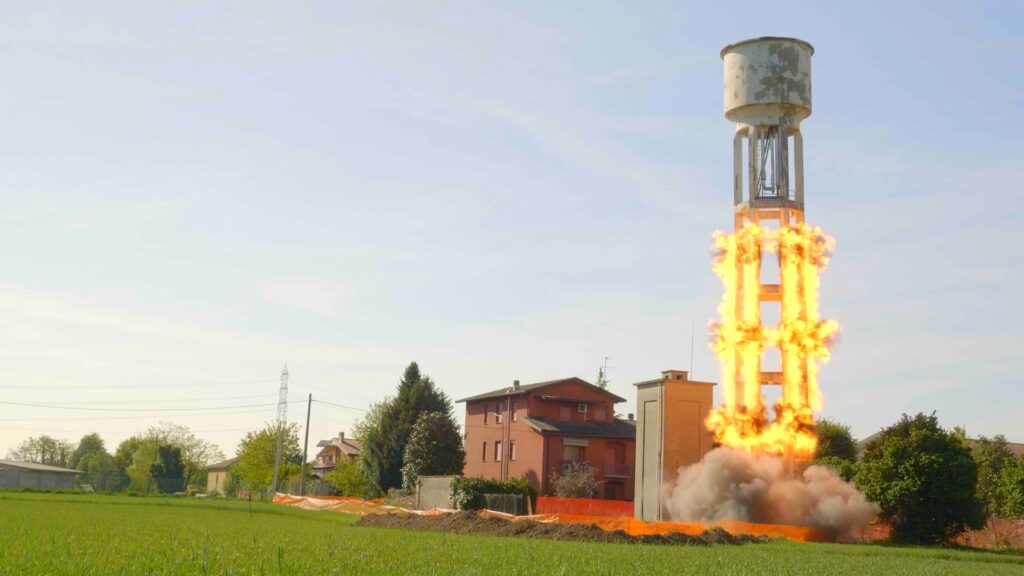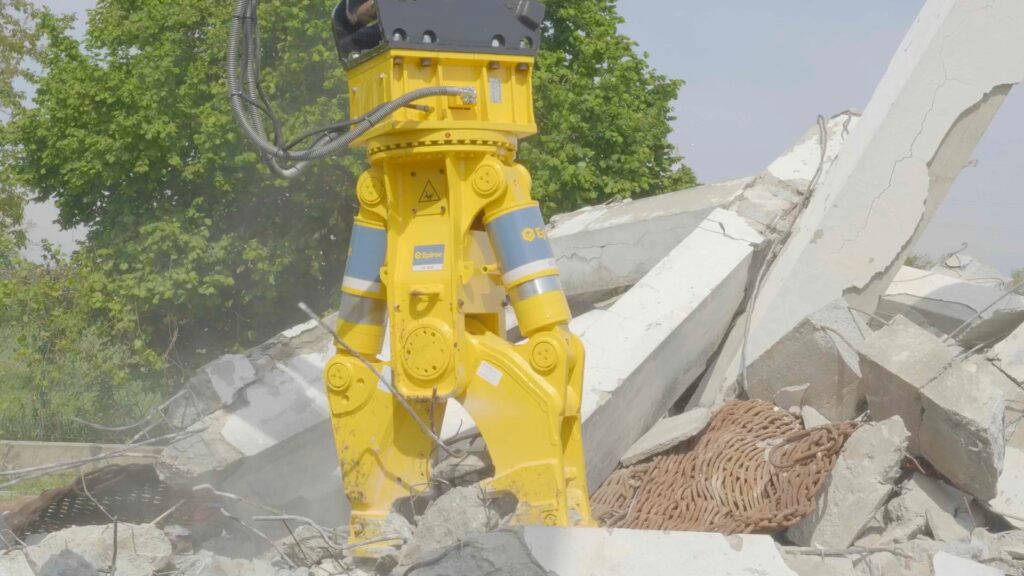The tower of the aqueduct of BrianzAcque in Vimercate (MB), Italy, was torn down a few weeks ago. A demolition carried out with explosives by Nitrex Explosive Engineering which, for the crushing of the structures demolished, chose the hydraulic Combi Cutter CC 1600 U from Epiroc.

These type of towers have shaped the skylines of so many towns and villages, as well as Italian cities, for a long time. They are the piezometric towers, better known as aqueduct towers, which are hydraulic disconnections raised from the ground by pylons made of reinforced concrete or iron that are filled with water thanks to a pump placed at their base aimed to ensure water supply to a given area.
Nowadays, most of them are unused and replaced by more modern and efficient pumping systems, so much so that their demolition is under way. In the Brianza (area close to Milan), after the demolition of the reservoirs hanging tanks in Seveso, Barlassina, Bovisio Masciago and Varedo, the Vimercate one was the last to fall recently, demolished by explosive by the Brescia-based company Nitrex Explosives Engineering, which, for the ground crushing of the structures, chose the hydraulic Combi Cutter CC 1600 U from Epiroc.
As Florin Pasca, site manager Nitrex, explains:
“Decommissioned since the 1960s, the Vimercate aqueduct tower was 32 meters and rested on a supporting structure consisting of six reinforced concrete pillars. With complete disconnection from the public aqueduct and showing all the signs of wear and tear over ages, BrianzAcque decided to demolish it. Given its particular location, in the suburbs of the built-up area and on the border with agricultural fields, it was possible to demolish it using explosives, a demolition technique that is well suited to the purpose as it has numerous advantages: it is cost-effective and obviously quicker than mechanical demolition, both in terms of execution and of subsequent clearing of the area, resulting in a minimal impact on the surrounding area and population.”

Nitrex, a company specialized in providing services in the field of explosives engineering with more than 30 years of experience, coordinated the demolition with the local police and the prefecture, agreeing on a precautionary one-hour evacuation of some families living in buildings located within 70 meters from the tower.
As Pasca points out:
“while there was no real danger, or even physical danger to those houses, we preferred to avoid the possibility of inconvenience due to more of a psychological factor related to such a demolition. While this is for us a routine job, like any demolition however, even if carried out through the use of explosives, we have approached it with the appropriate expertise and by resorting to the construction science: knowing the structure and the flaws in the structure can make all the difference. For example, the aqueduct tower of Vimercate had some structural defects due to economies in construction and the action of time, with weakened concrete and oxidized reinforcing bars: its demolition had to be approached, therefore, with a certain amount of care and attention, taking the necessary precautions. In the case of Vimercate, the tower was demolished in just seven seconds: the penthrite fuse was inserted into all six pillars, which were banded with special nets capable of enabling full containment of the fragment throw”.
As Pasca specifies:
“The façade fell, and had nothing except the iron and stones, with of course some noise, dust and created a little air displacement. Once the structure slumped to the ground. We proceeded to mechanical crushing on site using the Epiroc hydraulic Combi Cutter CC 1600 U, an exceptional cutter that allowed us to complete the crushing of the structure within a day and a half, at secondary crusher size thus creating fragments of about 20cm size, and extracting easily the iron from the concrete, for a total of about 150 cubic meters of rubble.”

Epiroc’s CC 1600 CombiCutter has three different jaws – identified by three letters that summarize its distinctive features: the U (Universal) stands for all types of concrete and rebar, the P (Pulverizer) for pulverizing demolition debris and the S (Steel) stands for cutting steel.
As Claudio Cossu Area Sales Manager of Epiroc, explains:
“the difference between these three versions is very little, so much so that it’s also the strength of these cutters, a kind of specialization and flexibility together. Concerning the equipment supplied to Nitrex, we chose a CC 1600 U, a 1600 kg hydraulic cutter suitable for excavators from 13 to 23 tons, precisely because it was to be mounted on a 13-ton excavator, specifically a CAT 313 Next Gen. The U jaw is 330 millimeter wide and mounts a double row of teeth, demonstrating a propensity for primary demolition of heavily reinforced concrete. In addition all three models U, P, S turn out to be particularly productive: being cutters with double cylinder configuration they are very strong, they are able to transfer very well the cutting force onto the material as well as being very fast: thanks to the speed valve that allows to speed up the extension or retraction of the cylinders, we are talking about an opening/closing cycle of 1.3 seconds. Above all, I would like to emphasize that in double-cylinder cutters, the cutting force is transferred more effectively because the two jaws are activated independently by their respective cylinders and there is no transverse component of resisting force that is created in single cylinders, this component tending to flex the excavator arm, on the one hand side it creates problems for the excavator itself because it creates mechanical stress and in the long run, in addition to creating wear and damage, goes to reduce the cutting force itself; moreover, from maximum opening to full closure a double clamp cylinder maintains the full force of the clamping force, when in contrast a single-cylinder cutter comes to lose as much as 30 to 40 percent of energy.”
Produced at the former Krupp plant in Essen, in Germany, Epiroc attachments are built with the highest quality materials, and as Cossu says:
“in addition to taking advantage of the company’s historical know-how, Epiroc works on high operating pressures, the CC 1600 U operates at 350 bar as the hydraulic supply pressure of the opening and closing circuit, so the forces that are developed are significant forces, we are talking about 197 tons in the innermost part of the blades as the maximum cutting force and 57 tons on the tips of the jaws, which, when put in relation to the opening and closing times, guarantees very good performance.”


 Copyright 2017-2025 All rights reserved.
Copyright 2017-2025 All rights reserved.